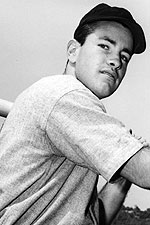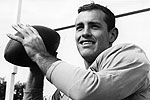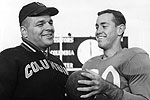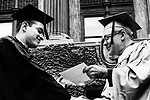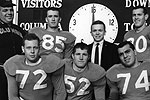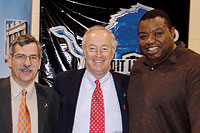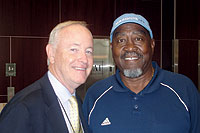FEATURES
How to Defuse Time Bombs
Quarterback-turned-surgeon Dr. Archie Roberts ’65
screens retired football players for heart disease
By Joshua Robinson ’08
 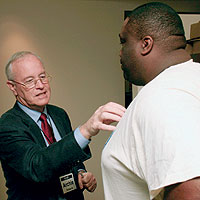
Dr. Archie Roberts ’65 (left)
talks with former Miami Dolphins
football player Keith
Sims at the Living Heart NFL
Players CV Health Program in
January in Miami
PHOTO: AP PHOTO/LUIS M. ALVAREZ

The score was 3–3, time was
running out and the Harvard football fans were turning hostile.
The Crimson had just tied Columbia with a field goal, and Lions
quarterback Archie Roberts ’65 was trying to silence them as he
marched the Light Blue toward the end zone.
As the clock ticked down on that October 1963 afternoon,
Roberts set up Columbia’s chance to win. It was only first or
second down and the Lions already were in position for a long
field goal. The horseshoe stadium in Massachusetts — among
those in attendance was President John F. Kennedy, who had taken the afternoon off to watch his alma mater — grew louder.
This was no time for indecision.
Roberts jogged over to the sideline to consult his coach,
Aldo “Buff” Donelli. “Let’s try one more play from scrimmage,”
Roberts argued. “We’ll throw into the end zone. If I’m
caught, I’ll just throw it away.” Donelli wanted to try the long
field goal right away, but the soft-spoken, deliberate Roberts
convinced his fiery coach otherwise.
Roberts lined up under center, the ball was slapped into his
hand and he dropped into the pocket. But as he cocked his
arm to throw, a hand came up. Suddenly, the wobbly pass was
up for grabs. “As luck would have it, it was intercepted and
that was the end of the game,” Roberts recalls of the tie.
Donnelli chased Roberts across the field and all the way
into the locker room, furious for having been talked into
changing his game plan.
Today, Roberts laughs when he tells that story, but when
the ball fell into Harvard’s hands, it was only funny to the
home fans, and possibly the President. Roberts often wonders “what in the world went through
Kennedy’s mind when he saw this
quarterback running into the locker
room with the coach behind him.”
Some 44 years after throwing
out the playbook against
Harvard, Roberts is the man
writing it, but this time the
objective isn’t the end zone. In 1998,
Roberts, who spent 30 years as a
heart surgeon at hospitals all over
the country after flirting with professional
football, founded the Living
Heart Foundation and has pioneered
advanced, mobile methods
for cardiovascular screening in an
attempt to raise awareness about
heart disease and the special risks for former football players.
Since 2003, the foundation has been sponsored by the National
Football League Players’ Association to conduct screenings of
retired players. In the past four years, Living Heart has screened
more than 1,300 players in 20 NFL cities. But Roberts believes
that they are just beginning to scratch the surface.
“The NFL has been built on a physical prowess and strength
and durability, and the idea of psychological or physical problems
has not been what the NFL has been about,” he says. “Nor has it
been the public’s image of NFL players. They look indestructible,
they look indefatigable, they look immortal. In that setting, it’s
hard to be scrutinizing and looking for defects in the product.”
When Roberts was playing football, there were only a handful
of 300-pounders in the NFL. By 1987, the number was up to
27 players who weighed 300 pounds or more. But as football
has followed the trend to bigger, stronger athletes, that figure
swelled to 240 by 1997; today the number is more than 350. “What doctors are learning is that size is a risk factor for heart
disease, just like hypertension, diabetes or high cholesterol are
risk factors,” Roberts explains.
And, he claims, as players make the transition from the professional
game to retirement, usually in their mid- to late-30s,
those health risks too often are neglected. The widely reported
figure for average life expectancy of an ex-NFL player is 55 — life
expectancy at birth for the average American male is 74.4 years,
according to a 2004 report by the Centers for Disease Control.
“I was aware of the collisions and concussion problems, the
things that the average observer of professional football
would know about,” says Roberts. “I also knew from having
been a player that while the team doctors and the teams delivered
a high level of healthcare for the active players, once the
players transitioned into retirement, there was quite a change.
When you retired, you were on your own.”
During the past year, a number of alarming studies regarding
the long-term effects of concussions on football players
have emerged, and retired professional players have made
public demands for better care from the league. Roberts
asserts the league is taking positive steps toward improving
care for retired athletes. Last July, the NFL and NFL Players’
Association announced the formation of the NFL Cardiovascular
Health Program, to which
Roberts is a consultant.
“Doctors have been thinking
more about short and long-term
consequences of professional football.
The owners, the players’
union and the players have spoken
out about better methods for the
players’ union to help them handle
the disabilities that occur after
football.”
This is Roberts’ way of giving back to the game that made his dream of becoming a doctor a reality.
At the College, Roberts lettered
in three sports — though he confesses
he was nothing special on the basketball court — and had the
option to play baseball or football professionally when he graduated.
Ultimately, however, sports wasn’t his long-term plan. “I
loved baseball and I loved football, but I wanted to become a
doctor, and that was the most important thing for me.”
The St. Louis Cardinals selected Roberts, a shortstop who
batted .386 his senior year, in baseball’s first college draft in
1965, while he was drafted in the seventh round by the New
York Jets as a quarterback, and subsequently signed by the
Cleveland Browns.
His numbers made him an obvious candidate for both pro
sports. In football, he played offense and defense, threw for
3,704 career yards, set 17 Columbia and 14 Ivy League records
and was the first quarterback in Columbia history to complete
300 passes. Donelli once said, “Archie Roberts is as fine a
quarterback as I have ever coached, and I believe he is in the
same class as the finest forward passers I have ever seen, men
like Sid Luckman [’39], Y.A. Tittle and Harry Agganis.”
To cap it all off, Roberts also led the Lions in punting.
On the baseball diamond, he set another Columbia record by
batting .371 for his career — that now ranks fourth all-time — and as a senior, Roberts led the nation with 30 RBIs in 21 games.
But it was the Browns who made him an offer he couldn’t
refuse: If Roberts signed with the pro football team, the
Browns would put him through medical school.
“The Columbia family was instrumental in helping to
arrange the opportunity with Case Western Reserve Medical
School and the Cleveland Browns,” he acknowledges. “I
remember in particular, Gene Rossides ’49, a former great running
back for Columbia, was helpful in contacting Art Modell,
who was then the owner of the Browns, and Doug Bond, the
dean of the medical school. Being in Cleveland, they knew one
another and the Browns had provided funding and grants for
the medical school.”
As far as Roberts knows, he is the only person to play professional
football and go to medical school during the season,
balancing his studies and football with remarkable discipline. “Given that both sides, the team and the medical school, were
willing to be flexible and creative and permit an unusual thing
to happen, I was given this opportunity,” he recalls. “It made
it possible in that era. In today’s
world, there’s too much demand
from medical school and football; it
wouldn’t be possible.”

“I was so busy taking care of my patients and teaching
and doing
research that I neglected my own health.”

As he approached the third of
his four years at Case Western
Reserve, Roberts still had not seen
a minute of competitive action for
the Browns. The starting spot
belonged to Frank Ryan, a quarterback
whose claim to fame was having
a Ph.D. in mathematics. Ryan
and Roberts’ best shot at NFL history
then might be as the answer to
a rather obscure trivia question:
“Who was the best educated
starter-backup quarterback tandem
in football?”
By 1967, Roberts thought the opportunity to be a bona fide
NFL quarterback might be passing him by. So when the ewlyformed
Miami Dolphins offered him a chance to start that season,
he jumped at it.
“But guess who was drafted as another quarterback?”
Roberts asks. “Bob Griese.” A future Hall-of-Famer, Griese
went on to play in seven Pro Bowls, win two Super Bowls and
lead the Dolphins through their perfect 17–0 season under legendary
coach Don Shula.
Roberts only played one game and left Miami after a single
season to return to Cleveland and finish his medical degree.
But he has never felt a twinge of regret. “The goal of medicine
was first and foremost. If I had ever been forced to choose, I
would have pursued medicine. I was very lucky to have this
opportunity along the way.”
During nearly 30 years as a cardiothoracic surgeon,
professor of surgery and researcher, Roberts racked
up his most impressive number. He may have
thrown for 3,704 yards in college, but he performed
more than 4,000 open-heart surgeries in the operating theater.
That came to an abrupt end in 1997.
While lecturing a group of cardiologists in New Jersey,
Roberts suffered a stroke. “I’d never been sick a day in my
life,” he explains. “I’d never been in the hospital as a patient
and didn’t have any obvious health issues. I was so busy taking
care of my patients and teaching and doing research that I
neglected my own health.”
In the immediate aftermath, Roberts displayed many of the
characteristic ailments of stroke survivors — trouble with
speech and impaired motor skills on one side of the body. He
could barely move the right arm that carried him through
Columbia to the NFL and finally to medicine. It hit him hard.
“It took me the better part of a year to come to grips with the
fact that I was not immortal and that health issues are unpredictable.
I decided to retire from heart surgery, because it’s a
stressful job with many long hours — probably not what I needed
to be healthy,” Roberts notes.
As he started on the long path to full recovery, he founded
Living Heart, based at Rutgers. The first screenings were
at high schools around Holyoke,
Mass., where he grew up, and the
Columbia football team.
Living Heart rose to prominence,
however, during the massive
rescue efforts following 9-11. A
group of 25 people from the nonprofit
foundation set up on the
Lower East Side and screened more
than 2,000 rescue workers who
were worried about the effects of
their exposure to the debris, smoke
and stress.
“When word got around the city
that someone in the health field
was reaching out,” Roberts remembers, “volunteers poured in from
the hospitals. We had more than
400 at the end of the two-week period … 14 consecutive days,
all day, all night. There’d be rescue workers lined up around
the block in the morning wanting to get in.”
Screening retired NFL players is a change of pace, but the
impact on people’s lives is no different. Roberts continues to
travel throughout the year conducting free screenings sponsored
by the NFL players’ union, as well as a few college football
teams.
With an estimated 18,000 retired players scattered
across the country, many of whom don’t respond to the
union’s invitations for a screening, he knows that cardiovascular
disease will continue to be a silent killer.
“There’s room for much more to be done,” he says. “It’s all a
process, and the league is finding a healthy way of approaching
things.”
Roberts didn’t make it past the fringes of the professional
game, but to many retired players, he may be the best teammate
they never had.
Joshua Robinson ’08 was Spectator’s sports editor in 2006. His
articles have appeared in The New York Times, Pittsburgh Post-Gazette and The Washington Post.
|





